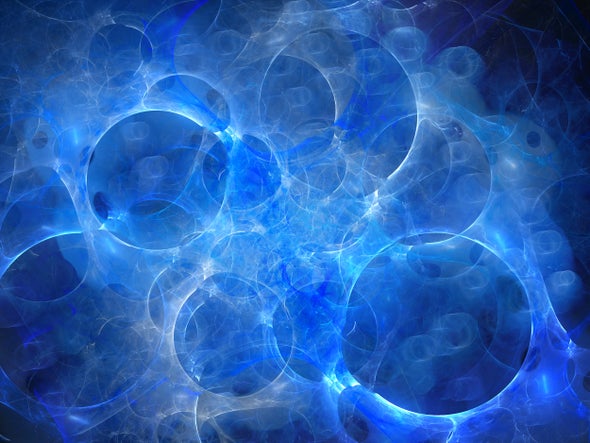
Astronauts describe the emptiness and darkness of space far from Earth as a startling experience. So did the poet Rainer Maria Rilke, in a poem e-mailed to me by writer Dror Burstein. Without ever having ventured into space (obviously), Rilke wrote a century ago: “Night, shuddering in my regard, but in yourself so steady; inexhaustible creation, enduring beyond the fate of earth.”
Is there a modern scientific interpretation to Rilke’s poem?
The reality is that space in neither empty nor dark. Even outside galaxies, an astronaut could find at least one proton, on average, in every cubic meter. Also, one electron and half a billion photons and neutrinos, all left over from the big bang. Still, one might naively imagine that the space in between these particles is empty. Indeed, the early atomists in ancient Greece thought that the vacuum is literally nothing.
Not so. A dominant fraction of the cosmic mass budget—roughly two thirds—is currently associated with the “dark energy” that pervades the vacuum, exerting a repulsive gravitational push on matter and accelerates the expansion of the universe. The latest measurements indicate that the vacuum behaves like the cosmological constant that Albert Einstein added to his equations a century ago when he considered the hypothetical possibility of a static universe, in which the attractive gravity of matter is balanced by the repulsion from the vacuum.
Our actual universe is not only expanding but doing so uniformly to within one part in 100,000, even for regions on opposite sides of our cosmic horizon that did not have time to communicate. The popular explanation for this apparent puzzle is cosmic inflation, an early period during which the vacuum triggered accelerated expansion for a limited time, so that regions which were initially close and in causal contact got ultimately separated by so much that they are now on opposite sides of our sky. If so, the vacuum dominated the expansion both at the beginning and the end of our cosmic history.
If we feel the need to find emptiness, we can imagine a hypothetical region outside the observed volume of our universe where the cosmological constant vanishes and there is no matter. Would this region empty? The answer is, again, no. According to quantum mechanics, it will still experience vacuum fluctuations, with virtual particles briefly coming in and out of existence. The reality of these transient fluctuations has been indicated experimentally through a number of effects. For example, when two metal plates are placed parallel to each other, they limit the wavelength of virtual electromagnetic fluctuations in the space between them, resulting in a force between them, the so-called Casimir effect.
Similarly, interaction between vacuum fluctuations and the electron in a hydrogen atom, produces an energy difference between the 2S1/2 and 2P1/2 states of the electron, and yielding the Lamb shift between their energy levels. Also, a strong enough electric field can accelerate virtual electrons and positrons from the vacuum, so that they materialize into real particles and give rise to the Schwinger effect of pair creation. In analogy, the strong gravity of the event horizon of a black hole generates thermal radiation from the vacuum and causes Hawking evaporation of this pure spacetime structure.
In fact, thermal radiation pops out of the vacuum not just in black holes, but in all systems that possess causal horizons. For example, an accelerating probe has a Rindler horizon from which it detects a thermal bath of radiation, providing the Unruh effect. Similarly, the horizon of an exponentially accelerating universe exhibits a de Sitter temperature. During the accelerated cosmic inflation, related fluctuations of the vacuum were generated and potentially seeded the present-day structures of galaxies and clusters of galaxies. If this happened, we owe our existence to early quantum fluctuations. The vacuum seeded life.
But we can consider even more foundational questions. Since the atomists were wrong and emptiness is nowhere to be found, what was there before the big bang? Did our universe emerge from a vacuum fluctuation? These questions can only be answered within the framework of a predictive theory of quantum gravity that combines quantum mechanics and gravity, which we do not have as of yet. Until it is developed, we will not figure out our cosmic roots.
As in the Schwinger effect, it is conceivable that a violent irritation of the vacuum potentially could create a baby universe. Whether that’s possible depends on subtle details and is a subject of active research, which I studied recently as the time reversal of a collapse to a black hole, with Paul Chesler, a postdoctoral fellow at Harvard’s Black Hole Initiative.
An artificial birth channel could have interesting implications for our own cosmic origins. If our universe was created in the laboratory of another civilization, one could imagine an infinite sequence of baby universes born out of each other by civilizations that developed the technological womb capable of giving birth to new universes. In this case, the umbilical cord of our big bang has its origin in a laboratory.
A universe is the greatest gift that an experimentalist could hope to get out of the vacuum. Inside, the gift might contain early atomists who consider the vacuum as empty, followed by scientists who end up creating a new universe out of it. What a spectacular interpretation that would be of Rilke’s phrase: “inexhaustible creation, enduring beyond the fate of earth.”
"creation" - Google News
December 13, 2020 at 12:00AM
https://ift.tt/3a56ERm
Endless Creation Out of Nothing - Scientific American
"creation" - Google News
https://ift.tt/39MUE4f
https://ift.tt/3bZVhYX
Bagikan Berita Ini














0 Response to "Endless Creation Out of Nothing - Scientific American"
Post a Comment